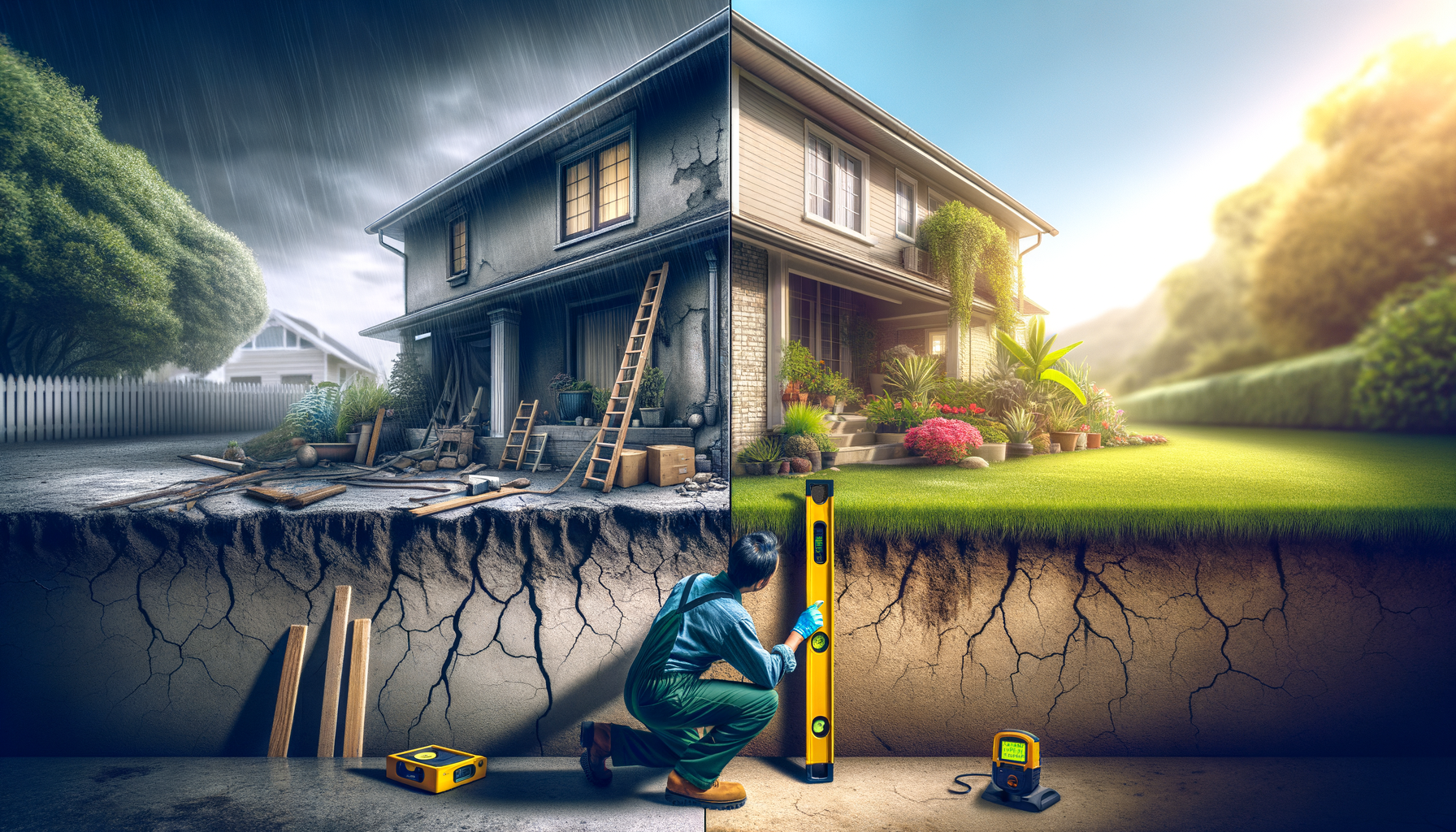What is Foundation Settling?
Definition
Foundation settling happens when a house’s foundation moves or sinks a little over time. This is a natural process because the weight of the house presses down on the soil under it. Knowing about foundation settling is important for homeowners so they can spot problems early.
Why it Happens
- Soil Movement: Changes in the soil, like when it gets wetter or drier, can cause settling.
- Natural Settling Over Time: It’s normal for homes to settle a bit as they get older.
Common Signs of Foundation Settling
Cracks in Walls and Floors
Foundation settling often causes cracks in walls and floors.
- Types of Cracks: Look for cracks that go sideways, up and down, or in a stair-step pattern in the walls or floors.
- What to Watch For: Small cracks are usually okay, but big or growing cracks can be a problem.
Doors and Windows Misalignment
- Operational Issues: If doors and windows are hard to open or close, it might be due to settling.
- Visible Gaps: Check for uneven spaces around doors and windows.
Uneven Floors
- Sloping Floors: Floors might feel like they are tilted or not level.
- Sagging: Some parts of the floor may feel soft or look like they are dipping down.
Gaps Around Windows and Doors
- Separation: Gaps can form between the window or door frames and the walls.
- Drafts: You might feel drafts or air coming in around windows and doors.
Causes of Foundation Settling
Soil Composition
The type of soil under your house affects foundation settling.
- Types of Soil: Some soils, like clay, can expand with water and shrink when dry, causing settling.
- Soil Condition: Loose soil or soil that isn’t packed down well can cause settling.
Water and Drainage Issues
- Excessive Moisture: Too much water from lawns, leaky pipes, or bad drainage can wash away soil, causing settling.
- Poor Drainage: Water collecting around your foundation can make settling worse.
Poor Construction
- Foundation Weaknesses: Bad design or using poor-quality materials can lead to settling.
- Construction Errors: Mistakes made during building, like not packing down the soil well, can also cause settling.
Temperature Changes
- Freeze-Thaw Cycles: In places where the ground freezes and thaws, the soil can move and cause settling.
- Extreme Weather: Big changes in weather, like droughts or floods, can quickly change soil conditions.
Effects of Foundation Settling
Structural Damage
- Cracked Foundations: Cracks in the foundation can be a serious problem.
- Wall and Ceiling Damage: Settling can make walls bow or lean and cause ceiling cracks.
Reduced Property Value
- Market Impact: Homes with foundation problems might be worth less because of repair costs.
- Selling Difficulties: Buyers might not want a house with foundation issues.
Safety Hazards
- Collapse Risk: In bad cases, settling can make a house unsafe.
- Injury Hazards: Uneven floors and stuck doors can make tripping and falling more likely.
Preventing Foundation Settling
Proper Drainage
- Gutter Systems: Make sure gutters guide water away from the foundation.
- Landscaping: Shape the ground to slope away from the house to help water flow away.
Soil Treatment
- Soil Stabilization: Add things to the soil to make it more stable.
- Compaction: Pack the soil well during building to help prevent settling later.
Maintain Consistent Moisture Levels
- Watering Schedule: Don’t overwater near the foundation.
- Moisture Barriers: Install barriers to keep soil moisture levels steady.
When to Call a Professional
Assessment Indicators
- Serious Signs: Big, constant cracks or sinking areas need a pro to check them out.
- Multiple Issues: If you see many signs of settling, call an expert.
Professional Inspection
- Benefits: Experts can find out how much settling has happened and why.
- Detailed Reports: They give detailed checks and repair advice.
Cost Considerations
- Initial Assessment: Paying for an inspection can prevent bigger problems later.
- Repair Costs: Knowing repair costs helps you plan and decide what to do.
Foundation Repair Options
Piering and Underpinning Techniques
- Techniques: Piers or underpinning can make the foundation stable by moving the weight to stronger soil.
- Durability: These methods keep the foundation stable for a long time.
Slab Jacking
- Process: This involves pumping stuff under the foundation to lift it back up.
- Effectiveness: Slab jacking works for small to medium settling problems.
Sealants and Waterproofing
- Preventative Measures: Sealants and waterproofing can protect the foundation from water-related settling.
- Maintenance: Check and keep up with these barriers for them to keep working.
Choosing the Right Foundation Repair Company
Research and Reviews
- Check Credentials: Make sure the company is licensed, insured, and has a good reputation.
- Read Reviews: Look at customer reviews to see how good their work is.
Get Multiple Quotes
- Comparison: Get quotes from different companies to see what they offer.
- Transparency: Pick a company that gives clear and detailed estimates.
Warranty and Insurance
- Warranty: Make sure they give a warranty on their repair work.
- Insurance: Check that they have insurance in case something goes wrong.
Maintaining Your Foundation
Regular Inspections
- Routine Checks: Have regular checks of your foundation to catch signs of settling early.
- Document Changes: Keep records of changes or problems for the future.
Proper Landscaping
- Plant Choices: Use plants with deep roots to help keep the soil stable.
- Placement: Don’t plant big trees or bushes too close to the house.
Addressing Minor Issues Promptly
- Timely Repairs: Fix small problems like tiny cracks or drainage issues before they get bigger.
- Professional Help: Get a pro if problems keep coming back or get worse.
Real-Life Stories
Case Studies
- Example 1: One homeowner found small cracks and got a pro. It was minor settling from bad drainage. Fixing the gutters and yard slope solved it.
- Example 2: Another homeowner ignored settling signs, leading to big damage. They needed piers to fix it, costing over $20,000.
Solutions Encountered
- Effective Repairs: These stories show how early fixes and getting experts can solve problems.
Lessons Learned
- Proactive Measures: Regular checks and maintenance can save on big repairs.
- Consult Professionals: Always get experts for accurate checks and fixes.
By learning what causes foundation settling and its signs, you can protect your home. Regular checks, good landscaping, and quick fixes are key to keeping your foundation stable. If you see major issues, call a pro right away. Doing so can save money and keep your home safe and valuable.


Leave a Reply